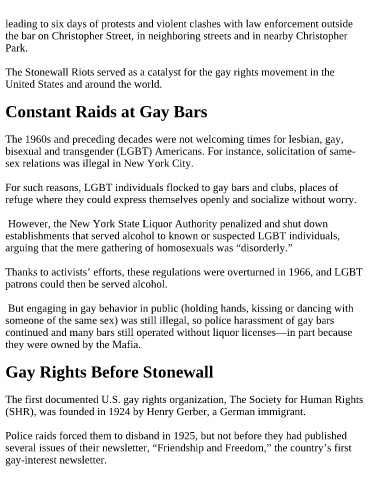Page 422 - ILIAS ATHANASIADIS AKA RO1
P. 422
leading to six days of protests and violent clashes with law enforcement outside
the bar on Christopher Street, in neighboring streets and in nearby Christopher
Park.
The Stonewall Riots served as a catalyst for the gay rights movement in the
United States and around the world.
Constant Raids at Gay Bars
The 1960s and preceding decades were not welcoming times for lesbian, gay,
bisexual and transgender (LGBT) Americans. For instance, solicitation of same-
sex relations was illegal in New York City.
For such reasons, LGBT individuals flocked to gay bars and clubs, places of
refuge where they could express themselves openly and socialize without worry.
However, the New York State Liquor Authority penalized and shut down
establishments that served alcohol to known or suspected LGBT individuals,
arguing that the mere gathering of homosexuals was “disorderly.”
Thanks to activists’ efforts, these regulations were overturned in 1966, and LGBT
patrons could then be served alcohol.
But engaging in gay behavior in public (holding hands, kissing or dancing with
someone of the same sex) was still illegal, so police harassment of gay bars
continued and many bars still operated without liquor licenses—in part because
they were owned by the Mafia.
Gay Rights Before Stonewall
The first documented U.S. gay rights organization, The Society for Human Rights
(SHR), was founded in 1924 by Henry Gerber, a German immigrant.
Police raids forced them to disband in 1925, but not before they had published
several issues of their newsletter, “Friendship and Freedom,” the country’s first
gay-interest newsletter.

